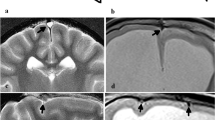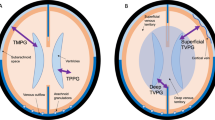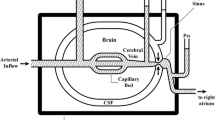Abstract
Little is known about intracranial venous pressure in hydrocephalus. Recently, we reported that naturally occurring hydrocephalus in Beagle dogs was associated with an elevation in cortical venous pressure. We proposed that the normal pathway for cerebrospinal fluid (CSF) absorption includes transcapillary or transvenular absorption of CSF from the interstitial space and that the increase in cortical venous pressure is an initial event resulting in decreased absorption and subsequent hydrocephalus. Further analysis, however, suggests that increased cortical venous pressure reflects the effect of the failure of transvillus absorption with increase in CSF pressure on the venous pressure gradient between ventricle and cortex. Normally, the cortical venous pressure is maintained above CSF pressure by the Starling resistor effect of the lateral lacunae. A similar mechanism is absent in the deep venous system, and thus the pressure in the deep veins is similar to that in the dural sinuses. Decreased CSF absorption causes an increase in CSF pressure followed by an increase in cortical venous pressure without a similar increase in periventricular venous pressure. The periventricular CSF to venous (transparenchymal) pressure (TPP) gradient increases. In contrast, cortical vein pressure remains greater than CSF pressure (negative TPP). The elevated periventricular TPP gradient causes ventricular dilatation and decreased periventricular cerebral blood flow (CBF), a condition that persists even if the CSF pressure returns to normal, particularly if tissue elastance is lessened by tissue damage. If deep CBF is to be maintained, periventricular venous pressure must increase. Since the veins are in a continuum, cortical venous pressure will further increase above the CSF pressure. Understanding these principles related to intracranial venous pressure helps in the selection of shunt characteristics that best match the pathologic condition.
Similar content being viewed by others
References
Adams J (1951) Tracer studies with radioactive (P32) on the absorption of cerebrospinal fluid and the problem of hydrocephalus. J Neurosurg 8:279–288
Bering EA, Sato O (1963) Hydrocephalus: changes in formation and absorption of cerebrospinal fluid within the cerebral ventricles. J neurosurg 20:1050–1063
Bowsher D (1957) Pathways of absorption of protein from the cereprospinal fluid: an autoradiographic study in the cat. Anat Rec 128:23–40
Branch CA (1988) An investigation into the relationship of cerebrovascular dynamics to intracranial pressures and pulsations. Thesis, Biomedical Sciences: Medical Physics, Oakland University
Castro ME, Portnoy HD, Maesaka J (1991) Elevated cortical venous pressure in hydrocephalus. Neurosurgery 29:232–238
Chopp M, Portnoy HD (1983) Hydraulic model of the cerebrovascular bed: an aid to understanding the volume-pressure test. Neurosurgery 13:5–11
Conner ES, Foley L, Black PMcL (1984) Experimental normal pressure hydrocephalus is accompanied by increased transmantle pressure. J Neurosurg 61:322–327
Cserr HF (1984) Convection of brain interstitial fluid. In: Shapiro K, Marmarou A, Portnoy HD (eds) Hydrocephalus. Raven Press, New York, pp 59–68
Davson H (1984) Formation and drainage of the cerebrospinal fluid. In: Shapiro K, Marmarou A, Portnoy H (eds) Hydrocephalus. Raven Press, New York, pp 3–40
Del Bigio MR, Bruni JE (1988) Changes in periventricular vasculature of rabbit brain following induction of hydrocephalus and after shunting. J Neurosurg 69:115–120
Eisenberg HM, McLennan JE, Welch K (1974) Ventricular perfusion in cats with kaolin induced hydrocephalus. J Neurosurg 41:20–28
El-Shafei IL, El-Rifaii MA (1987) Ventriculojugular shunt against the direction of blood flow. Child's Nerv Syst 3:282–291
Fishman RA (1966) Occult hydrocephalus (letter). N Engl J Med 274:466–467
Foltz EL (1984) Hydrocephalus and CSF pulsatility: clinical and laboratory studies. In: Shapiro K, Marmarou A, Portnoy HD (eds) Hydrocephalus. Raven Press, New York, pp 337–362
Glees P, Hasan M, Voth D, Schwarz M (1989) Fine structural features of the cerebral microvasculature in hydrocephalic infants: correlated clinical observations. Neurosurg Rev 12:315–341
Goldstein GW, Betz AL (1983) Recent advances in understanding brain capillary function. Ann Neurol 14:389–395
Greitz TVB, Grepe AOL, Kalmer MSF, Lopez J (1969) Pre- and post-operative evaluation of cerebral blood flow in low pressure hydrocephalus. J Neurosurg 31:644–651
Guyton AC (1981) Textbook of medical physiology, 6th edn. Saunders, Philadelphia
Hakim S, Hakim C (1984) A biomechanical model of hydrocephalus and its relationship to treatment. In: Shapiro K, Marmarou A, Portnoy HD (eds) Hydrocephalus. Raven Press, New York, pp 143–160
Hakim S, Venegas JG, Burton JD (1976) The physics of the cranial cavity, hydrocephalus and normal pressure hydrocephalus: mechanical interpretation and mathematical model. Surg Neurol 5:187–210
Hiratsuka H, Tabata H, Tsuruoka S, Aoyagi M, Okada K, Inaba Y (1982) Evaluation of periventricular hypodensity in experimental hydrocephalus by metrizamide CT ventriculography. J Neurosurg 56:235–240
Hochwald GM, Lux WE, Sahar A, Ransohoff J (1972) Experimental hydrocephalus: changes in cerebrospinal fluid dynamics as a function of time. Arch Neurol 26:120–129
Hoff J, Barber R (1974) Transcerebral mantle pressure in normal pressure hydrocephalus. Arch Neurol 31:101–105
Hopkins LN, Bakay L, Kinkel WR, Grand W (1977) Demonstration of transventricular CSF absorption by computerized tomography. Acta Neurochir 39:151–157
Kinal ME (1962) Hydrocephalus and the dural venous sinuses. J Neurosurg 19:195–201
Levin VA, Milhorat TH, Fenstermacher JD, Hammock MK, Rall DP (1971) Physiological studies on the development of obstructive hydrocephalus in the monkey. Neurology 21:238–246
Meyer JS, Kitagawa Y, Tanahashi N, Tachibana H, Kandula P, Cech D, Rose J, Grossman R (1985) Pathogenesis of normal-pressure hydrocephalus — preliminary observations. Surg Neurol 23:121–133
Milhorat TH (1970) Experimental hydrocephalus. I. A technique for producing obstructive hydrocephalus in the monkey. J Neurosurg 32:385–389
Milhorat TH, Clark RG, Hammock MK, McGrath PP (1970) Structural, ultrastructural, and permeability changes in the ependyma and surrounding brain favoring equilibration in progressive hydrocephalus. Arch Neurol 22:397–407
Milhorat T, Mosher MB, Hammock MK, Murphy CF (1970) Evidence for choroid plexus absorption in hydrocephalus. N Engl J Med 283:286–289
Nakagawa Y, Tsuru M, Yada K (1974) Site and mechanism for compression of the venous system during experimental intracranial hypertension. J Neurosurg 41:427–434
Pernkoff E (1963) Atlas of topographical and applied human anatomy. Saunders, Philadelphia, pp 32–33
Pollay M, Roberts PA (1980) Bloodbrain barrier: a definition of normal and altered function. Neurosurgery 6:675–685
Portnoy HD (1989) The physics of hydrocephalus: the LaPlacian model. In: Gjerris F, Borgesen SE, Sorensen PS (eds) Outflow of cerebrospinal fluid. (Alfred Benzon Symposium 27) Munksgaard, Copenhagen, pp 315–326
Portnoy HD, Croissant PD (1978) Megalencephaly in infants and children: the possible role of increased dural sinus pressure. Arch Neurol 35:306–316
Portnoy HD, Schulte RR, Fox JL, Croissant PD, Tripp L (1973) Antisiphon and reversible occlusion valves for shunting of hydrocephalus and preventing post-shunt subdural hematomas. J Neurosurg 38:729–739
Portnoy HD, Chopp M, Branch C (1983) Hydraulic model of myogenic autoregulation and the cerebrovascular bed: the effects of altering systemic arterial pressure. Neurosurgery 13:482–498
Sahar A, Hochwald GM, Ransohoff J (1969) Alternate pathway for cerebrospinal fluid absorption in animals with experimental obstructive hydrocephalus. Exp Neurol 25:200–206
Sainte-Rose C, LaCombe J, Pierre-Kahn A, Renier D (1984) Intracranial venous sinus hypertension: cause or consequence of hydrocephalus in infants? J Neurosurg 60:727–736
Sato O, Ohya M, Nojiri K, Tsugane R (1984) Microcirculatory changes in experimental hydrocephalus: Morphological and physiological studies. In: Shapiro K, Marmarou A, Portnoy HD (eds) Hydrocephalus. Raven Press, New York, pp 215–230
Shapiro K, Kohn IJ, Takei F, Zee C (1987) Progressive ventricular enlargement in cats in the absence of transmantle pressure gradients. J Neurosurg 67:88–92
Strecker EP, James AE jr, Konigsmark B, Merz T (1974) Autoradiographic observations in experimental communicating hydrocephalus. Neurology 24:192–197
Tokoro K, Chiba Y, Abe A (1991) Pitfalls of the Sophy programmable pressure valve: is it really better than a conventional valve and anti-siphon device? In: Matsumoto S, Tamaki N (eds) Hydrocephalus-pathogenesis and treatment. Springer, Tokyo, pp 405–421
Wozniak M, McLone DG, Raimondi A (1975) Micro- and macrosvascular changes as the direct cause of parenchymal destruction in congenital murine hydrocephalus. J Neurosurg 43:535–545
Author information
Authors and Affiliations
Rights and permissions
About this article
Cite this article
Portnoy, H.D., Branch, C. & Castro, M.E. The relationship of intracranial venous pressure to hydrocephalus. Child's Nerv Syst 10, 29–35 (1994). https://doi.org/10.1007/BF00313582
Issue Date:
DOI: https://doi.org/10.1007/BF00313582




